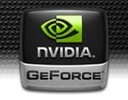NVIDIA GeForce 9300M G vs NVIDIA GeForce 9300M GS
NVIDIA GeForce 9300M G
► remove from comparison
Enhanced 8400M GS chip, which is manufactured in 65nm and shows slightly better performance due to a few minor optimizations. The technical data correspond to the 8400M GS chip.
A particularity of the graphic card are the "Unified Shaders" or ALUs (Arithmetic Logical Unit). There don't exist any dedicated pixel- or vertex shaders but 16 so called stream processors make the graphic tasks. The advantage is that theoretically there don't exist idle time of the ALUs. The NVIDIA stream processors are 1-dimensional (1D) and are able to accomplish one skalar operation with one MADD-operation (addition and multiplication). Moreover, NVIDIA clocks the shader ALUs somewhat higher than the rest of the chip.
An advantage of the GeForce 9000 series is the integrated PureVideo HD videoprocessor. It helps with the decoding of H.264-, VC-1-, MPEG2- and WMV9 video material in HD quality and therefore reduces the CPU load.
Probably, the memory clock of the GeForce 9300M G depends on the used memory type: 400 MHz with GDDR2 and 600 MHz with GDDR3 were used in 8400M cards.
NVIDIA GeForce 9300M GS
► remove from comparison
The Nvidia GeForce 9300M GS is a DirectX 10 capable graphics adapter for small and thin notebooks.
Compared to the old 8400M series or the 9300M G, the 9300M GS features only 8 unified shaders and is produced in 65nm. Furthermore, it integrates the new VP3 video processor (8400M, 9300M G had VP2) with more video features and better hd-video decoding support.
In conjunction with the Nvidia 9100M G integrated graphics, the 9300M GS supports Hybrid-SLI (HybridPower and GeForceBoost). HybridPower is a technique to choose between the integrated and dedicated graphics core, if performance or battery runtime is needed. This works only in Windows Vista. Up to now the user has to use a tool to switch between the GPUs. Later Nvidia wants to switch automatically in the drivers. GeForceBoost uses the integrated graphics core of the 9100M G and the dedicated of the 9300M in SLI mode to achieve better frame rates.
As the 8400M G, the 9300M GS features 8 stream processors that do the work of the former dedicated pixel- and vertex-shaders. The unified shaders of Nvidia are 1-dimensional (AMD has 5-dimensional shaders which leads to the higher number of shaders).
Compared to the old 8400M G, the 9300M GS has a higher core speed and is therefore faster. Modern DirectX 10 games will run only in low details and resolutions. Older DirectX 9 games, like HalfLife 2 or Far Cry run fluently in medium to high details.
Compared to desktop graphics cards, the upcoming 9300 GE / GS should be similar, as it will also stem from the G98 core. Still the desktop counterparts are usually higher clocked and therefore faster.
| NVIDIA GeForce 9300M G | NVIDIA GeForce 9300M GS | |||||||||||||
| GeForce 9300M Series |
|
| ||||||||||||
| Codename | NB9M-GS1 | NB9M-GS | ||||||||||||
| Pipelines | 16 - unified | 8 - unified | ||||||||||||
| Core Speed | 400 MHz | 550 MHz | ||||||||||||
| Shader Speed | 800 MHz | 1400 MHz | ||||||||||||
| Memory Speed | 600 MHz | 700 MHz | ||||||||||||
| Memory Bus Width | 64 Bit | 64 Bit | ||||||||||||
| Memory Type | GDDR2 / GDDR3 | GDDR2, GDDR3 | ||||||||||||
| Max. Amount of Memory | 256 MB | 256 MB | ||||||||||||
| Shared Memory | no | no | ||||||||||||
| API | DirectX 10, Shader 4.0 | DirectX 10, Shader 4.0 | ||||||||||||
| Transistors | 210 Million | |||||||||||||
| technology | 80 nm | 65 nm | ||||||||||||
| Features | 800 MHZ Shader-clock frequence, PureVideo technology (H.264, VC-1, MPEG2, WMV9 decoder acceleration), HDCP-capable, PowerMizer 7.0 energy management (dynamic switching between performance and energy saving), HDR (High Dynamic-Range Lighting), designed for Windows Vista, 16x full screen AA, 16x AF depending on the angle, 128-bit HDR illumination with AA, PCI-E 16x, OpenGL 2.1, Gigathread technology | |||||||||||||
| Date of Announcement | 01.02.2008 | 04.06.2008 | ||||||||||||
| Link to Manufacturer Page | www.nvidia.com | www.nvidia.com | ||||||||||||
| Power Consumption | 13 Watt |
Benchmarks
3DM Vant. Perf. total + NVIDIA GeForce 9300M GS
Average Benchmarks NVIDIA GeForce 9300M G → 100% n=7
Average Benchmarks NVIDIA GeForce 9300M GS → 99% n=7
* Smaller numbers mean a higher performance
1 This benchmark is not used for the average calculation
Game Benchmarks
The following benchmarks stem from our benchmarks of review laptops. The performance depends on the used graphics memory, clock rate, processor, system settings, drivers, and operating systems. So the results don't have to be representative for all laptops with this GPU. For detailed information on the benchmark results, click on the fps number.
Average Gaming NVIDIA GeForce 9300M G → 100%
Average Gaming 30-70 fps → 100%
Average Gaming NVIDIA GeForce 9300M GS → 120%
Average Gaming 30-70 fps → 118%
| NVIDIA GeForce 9300M G | NVIDIA GeForce 9300M GS | |||||||||||||
|---|---|---|---|---|---|---|---|---|---|---|---|---|---|---|
| low | med. | high | ultra | QHD | 4K | low | med. | high | ultra | QHD | 4K | |||
| Far Cry 2 | 33 | 7 | ||||||||||||
| Crysis Warhead | 22 | 2 | ||||||||||||
| Supreme Commander - FA Bench | 6 | |||||||||||||
| Crysis - GPU Benchmark | 24.7 | 9 | 28.76 | 5.02 | ||||||||||
| Crysis - CPU Benchmark | 21.6 | 8.6 | 25.9 | 9.1 | 4.75 | |||||||||
| World in Conflict - Benchmark | 10 | 5 | 12 | 6 | ||||||||||
| The Elder Scrolls IV - Oblivion | 20 | |||||||||||||
| Half Life 2 - Lost Coast Benchmark | 56 | |||||||||||||
| F.E.A.R. | 289 | 57 | 12 | 290 | 54 | 19 | ||||||||
| Doom 3 | 95.7 | 96.1 | 65.2 | 37.5 | 111 | 113 | 81 | 53 | ||||||
| Quake 3 Arena - Timedemo | 212 | |||||||||||||
| NVIDIA GeForce 9300M G | NVIDIA GeForce 9300M GS | |||||||||||||
| low | med. | high | ultra | QHD | 4K | low | med. | high | ultra | QHD | 4K | < 30 fps < 60 fps < 120 fps ≥ 120 fps | 2 1 1 | 3 1 1 | 2 1 | 1 | | | < 30 fps < 60 fps < 120 fps ≥ 120 fps | 3 1 1 1 | 2 1 1 | 7 1 1 1 | 1 1 | | |
For more games that might be playable and a list of all games and graphics cards visit our Gaming List






















